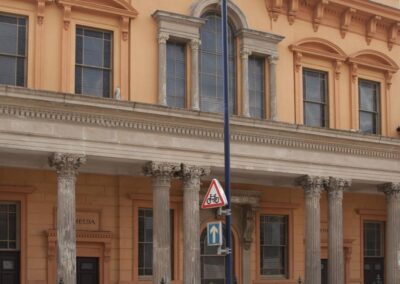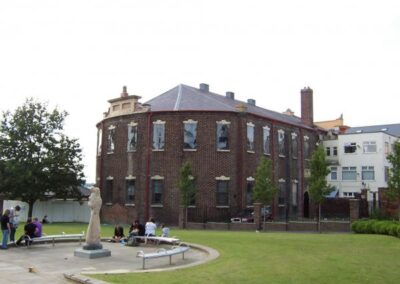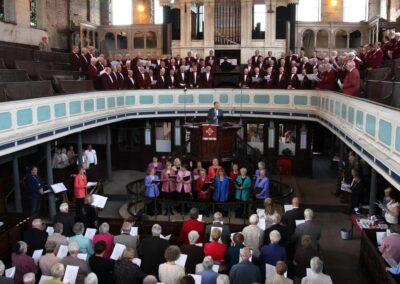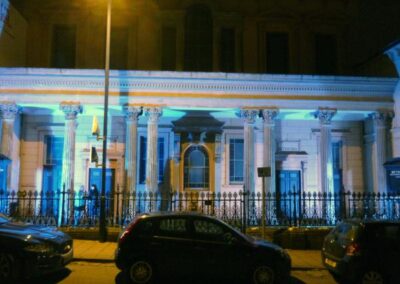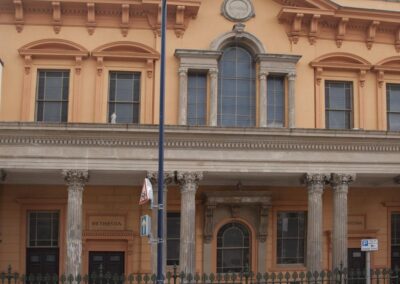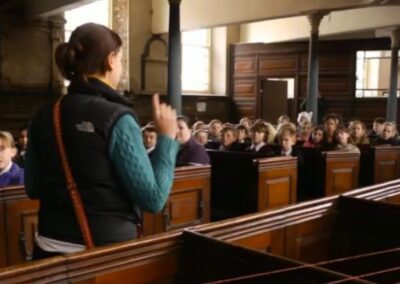Bethesda
Bethesda Methodist Chapel – known locally simply as ‘Bethesda’ – was designed to seat 2,000 people. It was notable also for the prominent roles in civic life played by its trustees during the 19th century when Bethesda became Stoke’s leading place of worship. It was often called the ‘Cathedral of the Potteries’.
Open Days
The Friends of Bethesda hold Open Days monthly on Saturday afternoons to raise money for Bethesda’s upkeep and restoration. See the website for details and for musicians performing at Open Days.
Directions
The chapel stands in Albion Street near the junction with Bethesda Street. There are WCs and refreshments are available in the Potteries Museum and Art Gallery opposite during Museum opening hours.
Rail station: Stoke-on-Trent, approximately 2 miles away.
Frequent bus service to Hanley Town Centre and to Stoke Bus Station (5 minutes walk from Bethesda).
Opening Times
Bethesda is normally open to the public on Open Days monthly on Saturday afternoons from April to October. For details of forthcoming Open Days and musicians performing please check the Friends of Bethesda’s website before making a journey.
Bethesda Mug
A mug decorated with drawings of Bethesda and made in Stoke-on-Trent, is available. To purchase, please send a cheque for £7.95, payable to ‘Historic Chapels Trust’ to Lynn Bentley, Battle steads, Alton, nr Stoke-on-Trent ST10 4BE. Please allow three weeks for delivery.
Address
Albion Street
Hanley
Stoke-on-Trent
ST1 1QF
United Kingdom
To contact the Friends please email the Secretary of HCT’s local volunteer committee.
Bethesda is an impressive building, seating up to 2,000 people, and notable also for the prominent roles in civic life played by its trustees during the 19th century when Bethesda became Stoke’s leading place of worship.
The present building, dates from 1819 and was built by members of the Methodist New Connexion to plans provided by a Mr. Perkins.
It replaced an earlier chapel of 1798 on the same site. The rear elevation overlooked the burial ground (now a public park) and is handsome with chequered brickwork and quite plain.
The main entrance on Albion Street is, on the other hand, intended to impress. Here local architect Robert Scrivener created a stuccoed Italianate frontage with a portico added to the chapel in 1859. Inside, stairs to right and left lead up to the very spacious gallery, with tiers of raked seats rather like a theatre. This gave everyone a clear view of the preacher.
A towering mahogany pulpit of 1856 is accessed by a double flight of stairs. It was also designed by Robert Scrivener and ensured that the preacher could also be heard by everyone. The gallery is supported on 24 slim iron columns. The ground floor pewing was renewed in 1887 and new windows installed with ornamental margin lights. There is a one-story vestry block on the west side along Bethesda Street which was formerly separately registered for religious marriages – it was used for smaller ceremonies than those held in the chapel itself.
Guidebook
A guidebook to Bethesda is available by post. Send your cheque for £8.00 (payable to Historic Chapels Trust) to Historic Chapels Trust, St George’s German Lutheran Church, 55 Alie Street, London E1 8EB.
Bethesda Methodist Chapel came to national attention in the 2003 BBC 2 series Restoration, where it was a finalist. The ‘champion’ of the chapel on the programme was historian Tristram Hunt.
This handsome place of worship in the centre of Hanley had long been a cause for concern, having been abandoned by the Methodists in the 1980s. HCT secured sufficient funding to stabilise the structure of the building and prevent its roof from collapsing, as it was at risk of doing due to extensive wet and dry rot. This phase of work alone has cost around £900,000 supported by generous grants from Historic England and the Heritage Lottery Fund.
The burial ground was passed to Stoke Council and laid out as a public park, though some monuments have been kept.
A second phase of work costing over £600,000, completed in August 2011, included essential external and internal repairs, including galleries, pulpit and staircases. A historic organ was rescued from elsewhere and given a new home – the original had been lost to vandalism while the chapel lay empty. New railings on the street elevation were cast to match the original design.
In 2018, the Friends of Bethesda began their next project,converting part of the detached external vestry building to be able to provide toilet facilities for people attending events. With a very generous grant from The Council of the City of Stoke on Trent, and with a huge fundraising effort, money was provided to install water and electric, internal redocoration and three toilets and wash basin facilities were installed. An accessible external path was also laid to ensure that the toilets can be accessed by everyone.
The Friends hope the next phase of the project will include converting the rest of the vestry building to offer a meeting room and kitchen facilities.
HCT’s work at Bethesda is informed by a Conservation Statement.
Bethesda is now structurally safe and has been stabilised, but much remains to be done to make it fully usable again.
To enquire about holding an event at Bethesda please contact the Friends of Bethesda.


